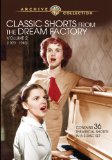| Reviews & Columns |
|
Reviews DVD TV on DVD Blu-ray 4K UHD International DVDs In Theaters Reviews by Studio Video Games Features Collector Series DVDs Easter Egg Database Interviews DVD Talk Radio Feature Articles Columns Anime Talk DVD Savant Horror DVDs The M.O.D. Squad Art House HD Talk Silent DVD
|
DVD Talk Forum |
|
|
| Resources |
|
DVD Price Search Customer Service #'s RCE Info Links |
|
Columns
|
|
|
Classic Shorts from the Dream Factory: Volume Two
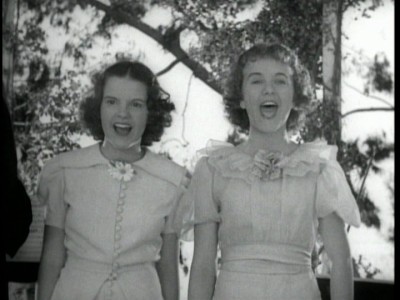
The Movies:
Among the things I learned from watching Classic Shorts from the Dream Factory, Volume 2 (1929-1946) - the enduring swing tune "Sing Sing Sing" actually has lyrics!
For this wonderful made-to-order DVD set, Warner Archive once again combs through the less-explored corners of Metro-Goldwyn-Mayer's film library for eclectic, delightful one and two reelers. While the Archive's first set, Classic Musical Shorts from the Dream Factory, came loaded with MGM's often surreal Technicolor musical experiments from the early to mid-1930s, volume two's selections are mostly 1936-39 vintage shorts with a jazzy, swingy panache. A few of these have previously been released as extras on Warner Bros. feature film DVDs, while others could be seen depending on the whims of the programmers at Turner Classic Movies - either way, it's a kick to be able to catch these crazy, cool shorts whenever I please.
Classic Shorts from the Dream Factory proves that short films of all kinds held a very important place in Hollywood's classic-era studio system. They kept moviegoers glued to their seats (back when the studios owned the theaters), served as handy outlets for experimental sound and film methods (such as Technicolor, too expensive to use in feature films), and made for a low-risk method to try out out the skills of young actors, singers, musicians and directors. As the film industry's biggest and most prolific studio, MGM took full advantage of its short-film unit - sure, they may lack the polish of the films they supported, but the best among them have an impetuous zing lacking in the main features. Amazingly, the 36 shorts collected here represents a mere fraction of their output. In 1937 alone, MGM produced a total of 70 live-action shorts - wow!
One still-enjoyable example of the star-building power of MGM shorts came with 1936's Every Sunday, pictured on this set's cover. As part of MGM's "Tabloid Musical" series of black and white mini-musicals, Every Sunday was used as an audition of sorts for a pair of gifted teenage singers who were considered for contracts at the studio - Judy Garland and Deanna Durbin. In this wholesome, small-town story, Deanna and Judy play perky best friends who attempt to improve attendance at the outdoor band concerts (conducted by Deanna's grandfather) held every Sunday at the local park. To stop the city from cancelling the concerts, the two canvass the neighbors with phone calls. While that does some good, they ultimately draw in the crowds by wowing them with their own singing - Deanna with her trilling soprano, and Judy with her jazzy scatting. This particular short stands out for several reasons. The two girls have tons of talent and poise, and this admittedly slight vehicle is a perfect fit for them. Although a few of these shorts have "before they were stars" sightings, this one is unusual in having two actors on the cusp of fame (another one is Annie Laurie from the same year, with Ann Rutherford and Dennis Morgan as Irish sweethearts). The behind-the-scenes tale on Every Sunday has passed into legend, although one has to wonder why MGM went with signing just one of the girls to a contract. Anyhow, things worked out fine for both - Garland became a legend at MGM, while Durbin did fantastically as Universal Studios' top-grossing star for several years.
Every Sunday aside, there's a lot of less-heralded pleasures to be found on Classic Shorts from the Dream Factory, Volume 2 (1929-1946). Here they are, spread over three discs:
Disc One
Copy (1929) - Roscoe Karns, an actor usually thought of as a comedian, has an effective dramatic turn here as a sensation-seeking newspaper editor who has an epiphany when the hot story he's covering takes on a personal turn.
The Rounder (1930) - Jack Benny stars in this non-musical comedy as a drunken, sniveling young playboy who arranges a quickie marriage with Ethel (Dorothy Sebastian), a vengeful heiress abruptly jilted by her fiancee.
Gentlemen of Polish (1934) - Shaw & Lee, a slapstick comedy duo in the Laurel & Hardy mold, have their day in this short. Escaping the cops, they crash a fancy party where lavish musical numbers (taken from other films?) transpire.
Gypsy Night (1935) - This "Colortone Musical" follows two gypsy children who steal toys from the camp puppeteer's wagon, then have a horrific nightmare. Bizarre and wonderful.
Memories and Melodies (1935) - A fictionalized account of the twilight years in American songwriter Stephen Foster's life, shot in beautiful Technicolor with some enjoyably non-p.c. numbers.
Two Hearts in Wax Time (1935) - Another weird-ass Technicolor curiosity with a drunken department store custodian hallucinating that the store's mannequin-filled display windows have come to life. Includes a memorable bit with Captain Kidd, Fu Manchu, Bluebeard and Frankenstein's Monster.
Violets in Spring (1936) - Made with stylized camera angles and unusually daring montages, this zippy boy-meets-girl-in-the-city musical short served as a fine vehicle for up-and-coming actors Virginia Grey and George Murphy.
New Shoes (1936) - This "Tabloid Musical" has a winsome Arthur Lake (Dagwood from the Blondie films and TV show) as a young man at a shoe store who woos another customer in song - with the footwear joining in!
Swing Banditry (1936) - Georgie Stoll and His Orchestra maneuver themselves into the same elevator with a radio station manager they were desperate to audition for. Lots of lively numbers (including "Sing Sing Sing" with lyrics); eternally flustered comic actor Franklin Pangborn has a bit as a radio station employee.
No Place like Rome (1936) - This bit of ancient history musical comedy fluff predates A Funny Thing Happened on the Way to the Forum by a few decades. Frank Albertson plays a happy Roman bachelor who falls for a lovely slave girl, in a silly tale that uses stock footage from MGM's silent Ben Hur.
Annie Laurie (1936) - MGM starlet Ann Rutherford teams up with Dennis Morgan (billed as Stanley Morner) in this romantic fantasy of two young lovers caught in the middle of Scotland's battle for the throne in the 18th century.
Every Sunday (1936) - Judy Garland and Deanna Durbin's audition reel - contemplate whether Louis B. Mayer really said "dump the fat one" (Garland) after seeing this.
A Girl's Best Years (1936) - Musical with baritone John Warburton as a wealthy songwriter who hires lady reporter Sheila Terry to keep his lawsuit-happy ex-girlfriends at bay. Even by MGM standards, this is one handsomely produced short.
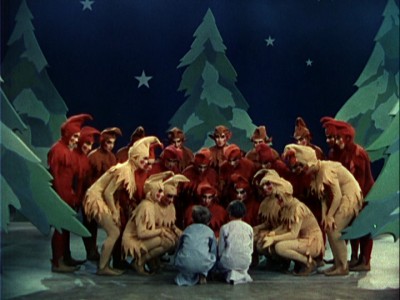
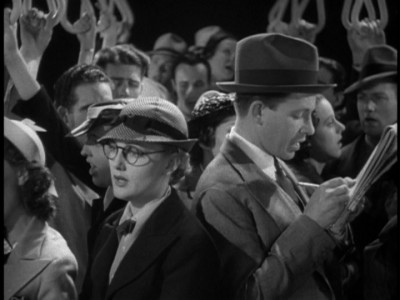
Disc Two
Dancing on the Ceiling (1937) - Another "Tabloid Musical" with some wild, Streamline Moderne-styled set pieces, highlighted with a number where a lustful dental patient gets gassed and dreams up a roomful of pretty upside-down dental assistants (you guessed it) dancing on the ceiling.
Bars and Stripes (1937) - More swing and youthful exuberance as a college jazz band (headed by handsome actor Dick Winslow) attempts to correct their lack of a suitable practice space by getting themselves thrown in jail. Whatever works, fellas.
Some Time Soon (1937) - In this "Miniature Musical Comedy," a factory worker keeps pining away for her Prince Charming to rescue her, unaware that her co-worker is a nobleman in disguise. MGM seems to have set up Jean Chatburn and Gregory Gaye in this as an alternate Jeanette MacDonald and Nelson Eddy.
The Little Maestro (1937) - Diminutive comic Jerry Bergen does a Chaplin-esque act as a mute hobo who pretends to be a talented violinist to gain a free meal at a swanky nightclub.
Song of Revolt (1937) - Coming off a bit like MGM's Passing Parade historical shorts, this one has actor Leon Ames (Meet Me in St. Louis) as the French songwriter who composed that country's national anthem, "Les Marseillaise." Ames' singing voice is dubbed and the French Revolution footage is borrowed from A Tale of Two Cities.
Carnival in Paris (1937) - Ann Rutherford returns in this charming romantic fantasy, playing a poor French waif who meets a friendly museum custodian (Henry Brandon) during carnival season in Paris. The attractiveness of the two leads bolster the forgettable music and dubbed singing.
The Canary Comes Across (1938) - As a prison warden's daughter who conducts the jail's glee club, Virginia Grey seems to be the sole plus on this silly, confusing story. Strong-voiced Erik Rhodes is Grey's love interest as a singing convict with an exact duplicate.
Snow Gets in Your Eyes (1938) - Enjoyable fluff set at a department store's indoor skiing competition; the singing Dandridge Sisters add some swing. This was the last MGM short for hard-working actress Virginia Grey, before appearing in features like Idiot's Delight and The Women.
The Magician's Daughter (1938) - Prolific character actor Frank Albertson plays a journalist attempting to uncover the secrets of a local magician, only to end up falling for the man's daughter (Eleanor Lynn).
It's in the Stars (1938) - College frolics with a fraternity and sorority reluctantly passing a measure to stop dating each other so their grades improve. Finding the notion preposterous, the school's Astronomy professor schemes a way to reunite the student body.
Streamlined Swing (1938) - Buster Keaton directed this brief showcase for The Original Sing Band, a talented group of black entertainers who could mimic various jazz instruments using their voices. Lively numbers in this brisk piece.
Men of Steel (1938) - Obscure singers Kenny Stevens and Doris Western get their time to shine in this peppy tale of washing machine factory workers putting on a show which moves on to the footlights of Broadway.
Once Over Lightly (1938) - Mustachioed comic Billy Gilbert stars in this broad satire of college life, with two fiercely competitive barber schools facing off in a heated competition.
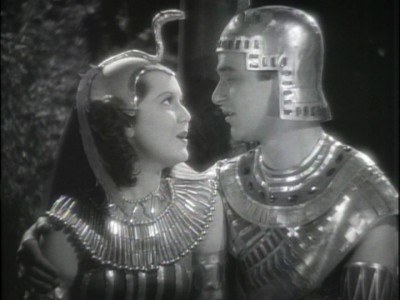
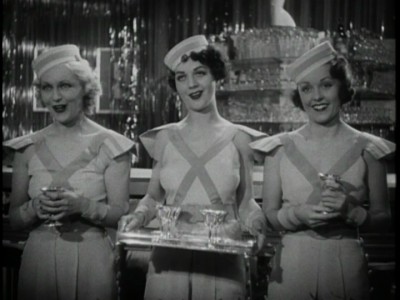
Disc Three
A Dream of Love (1939) - Aging composer Franz Liszt (Ian Colin) recalls a great romance from his past after receiving an unexpected package. This historic two reeler was directed by James A. FitzPatrick (he of the Travel Talks shorts).
Somewhat Secret (1939) - The popular motif of Swing Versus Classical gets another go-round with this perky college musical. A prim lady principal declares her school a Jitterbug-free zone, not knowing that her professor boyfriend conducts a hot Swing band on the side.
Happily Buried (1939) - Comedian Benny Rubin plays an Indian Yogi in this strange tale of strife between competing waffle iron manufacturers - with lavish musical numbers (you can't make this stuff up).
Rhumba Rhythm (1939) - Another of MGM's excuses for music, mayhem and star cameos (look, it's Lana Turner!). Sally Payne and Mary Treen play star-struck girlfriends who sneak into Hollywood's fabulous La Conga nightclub.
Love on Tap (1939) - Director George Sidney (Annie Get Your Gun) guides this densely plotted drama with dance sequences, centered around an arrogant woman (Mary Howard) who keeps postponing the wedding to her patient fiancee (Truman Bradley). This one was filmed at the now-demolished Ambassador Hotel in Los Angeles.
Mendelssohn's Wedding March (1939) - A candy-colored account of the creation of Felix Mendelssohn's immortal "Wedding March," it's another historically suspect musical short directed by James A. FitzPatrick (color me surprised that he did other stuff besides travelogues).
Heavenly Music (1943) - The sole Academy Award-winner on this set, this lightweight musical comedy concerns a Swing bandleader (Frederick Brady), who must pass judgment from a panel of history's most famous composers before getting accepted into the Pearly Gates.
Ode to Victory (1943) - MGM's self-promoting clip show and stirring wartime propaganda rolled into one, this patriotic short tells the history of America through songs both old ("Battle Hymn of the Republic") and new ("Ode to Victory").
Spreadin' the Jam (1945) - This lively, Swing music-filled short puts the well-worn "Let's put on a show" plot to good use as a rent-deprived young woman gets help from the other tenants in her apartment to convince the landlady to let her stay.
Musical Masterpieces (1946) - A singing couple (Carlos Ramirez and Lucille Norman) perform creatively staged renditions of classical pieces in this fun, lightweight piece - one of the few directing efforts from MGM's longtime Art Director Merrill Pye.
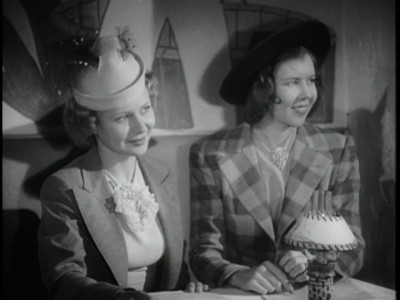
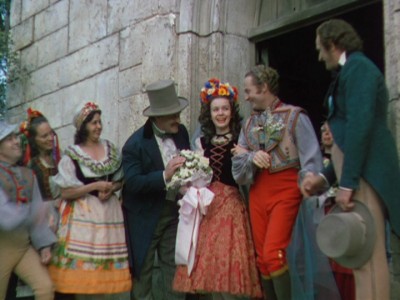
The DVDs:
Classic Shorts from the Dream Factory, Volume 2 (1929-1946)'s three made-to-order (m.o.d.) DVDs some in a standard size keep-case with hinged partition for the first two discs. Although the menu designs use Warner Archives' generic backlot photo, each disc sports a custom label. The back cover lists all the titles and their years of release.
Video:
The set uses unvarnished source prints with a fair amount of dust and age, and a few instances of discoloration (faint magenta and green areas on A Girl's Best Years, for instance). Most of the shorts (on average) have held up better, quality-wise, than many feature films released on Warner Archive. For the amount of footage on each disc, there are not too many compression issues. They did a spiffy job with this!
Audio:
The age and narrow dynamic range of mono makes this set an unvarnished listen, not as polished on the earliest films but quite agreeable and clean on shorts from the late '30s onward. No subtitle options are provided.
Extras:
While the 2006 TCM production Added Attractions: The Hollywood Shorts Story would have been a welcome bonus on the set, the shorts themselves are the sole attraction.
Final Thoughts:
As someone who especially loves the vintage shorts collections put out by Warner Archive, the sight of Classic Shorts from the Dream Factory, Volume 2 (1929-1946) in the DVD Talk screener pool made this reviewer jump for joy. The selections are all over the place, entertainment-wise, yet taken as a whole they reinforce the role of '30s-'40s MGM as Hollywood's most lavish studio. Considerately done, niche-driven sets like this truly epitomize what the made-to-order DVD business was created for. For those vaguely considering buying this one, I say dig in and enjoy. Highly Recommended.
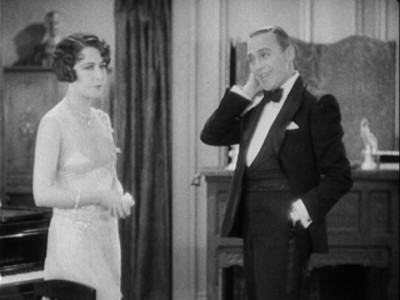
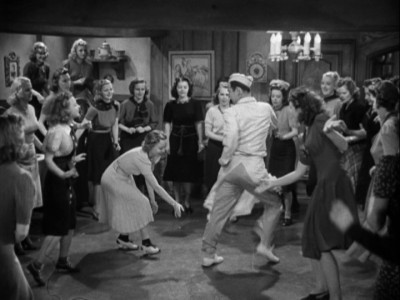
Matt Hinrichs is a designer, artist, film critic and jack-of-all-trades in Phoenix, Arizona. Since 2000, he has been blogging at Scrubbles.net. 4 Color Cowboy is his repository of Western-kitsch imagery, while other films he's experienced are logged at Letterboxd. He also welcomes friends on Twitter @4colorcowboy.
|
| Popular Reviews |
| Sponsored Links |
|
|
| Sponsored Links |
|
|
| Release List | Reviews | Shop | Newsletter | Forum | DVD Giveaways | Blu-Ray | Advertise |
|
Copyright 2024 DVDTalk.com All Rights Reserved. Legal Info, Privacy Policy, Terms of Use,
Manage Preferences,
Your Privacy Choices | |||||||









